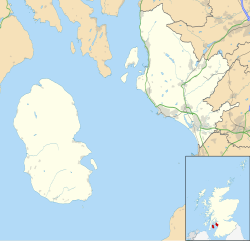Sannox
| |
|---|---|
 Sannox Bay in 2011 | |
Location within North Ayrshire | |
| OS grid reference | NS015455 |
| Civil parish |
|
| Council area | |
| Lieutenancy area | |
| Country | Scotland |
| Sovereign state | United Kingdom |
| Post town | ISLE OF ARRAN |
| Postcode district | KA27 |
| Dialling code | 01770 |
| Police | Scotland |
| Fire | Scottish |
| Ambulance | Scottish |
| UK Parliament | |
| Scottish Parliament | |
Sannox (Scottish Gaelic : Sannaig) is a village on the Isle of Arran, Scotland. The village is within the parish of Kilbride. [1] The name comes from the name the Vikings gave to the area, Sandvik, meaning the Sandy Bay.


